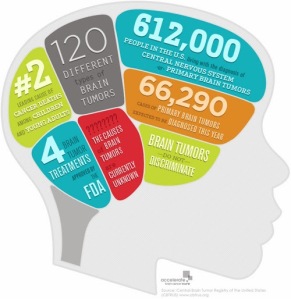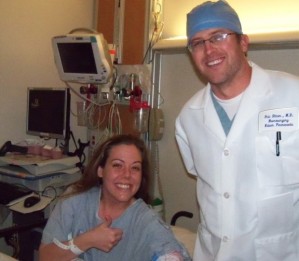This is part 2 of my thoughts concerning the article: Sheryl Crow: ”I have a brain tumour – but I don’t want it removed” that appeared in the tabloid the Daily Mirror. At the end of part 1, I stated that I am pretty sure that I owe Sheryl Crow an apology and said that I would detail why in this post. Be forewarned, this post will wander across a number of related topics, but I think it does all stay on the general point.
My mistakes last week were that: I didn’t notice that the story only showed up in a tabloid; l allowed myself to be sucked into the article’s title; took things out of context; and zeroed in on part of one sentence attributed to Sheryl Crow. In retrospect, what I did was no worse than tabloid reporting – I sensationalized information about a celebrity to suit my agenda. I apologize to Sheryl Crow (if she is listening), to my friends on Twitter, Facebook, Google+ and to the social media brain tumor community.
What got me worked up was what I viewed as a dangerous commentary on the gravity of a brain tumor diagnosis. My worry is that people would watch Crow’s reactions to her brain tumor and make decisions based on that instead of medical science. There is a sort of vacuum out there regarding brain tumors, and I just don’t want it filled by the wrong things.
Upon further review of the article, it appears to me that Crow has faced the reality of her diagnosis and had to make the choices we all have to make regarding quality of life. Who am I to criticize her choices? I have no idea of her particular circumstances. All I know is that she has a meningioma, which is a benign brain tumor, one that grows slowly. As with any tumor, so many factors matter: How big is it? Where is it? Has it “shown” itself with side effects (seizures, double vision, etc.)? If it has shown itself, in what manner has it done so? How aggressive is it? How old is the patient? What is the overall health of the patient? What attitude does the patient have? What is the standard treatment and its risks? What is the most aggressive treatment and its risks? What would happen if nothing is done? All of this makes for a very complex and difficult decision.
I can only assume that Crow has taken all these data points into consideration, together with any relevant other information to arrive at her treatment decisions. Additionally, the whole cancer thing is not new to her having survived breast cancer. The mistake that I and others have made or will make is to assume either that her decisions are right or wrong or that she is championing a course of action for others.
Now comes the difficult part of this post: my own situation and decisions are “just as bad” as Crows, leaving me even less room to criticize Crow. The recommended treatment for my tumor type is surgery followed by concurrent chemotherapy and radiation. I did not have surgery and did chemotherapy and radiation sequentially, with chemotherapy coming first.
You might ask why on earth would somebody choose to vary from recommended treatment. Just like I now assume Crow did, I balanced the factors that are unique to me and made my decision. Here are some of the things that came into play:
- Although it graded malignant, my brain tumor is a slow growing.
- The location of my tumor is favorable.
- My tumor has a genetic anomaly that makes it more vulnerable and responsive to a particular chemotherapy and to radiation.
- There were almost no outward signs of the presence of the brain tumor.
- The tumor did not have defined edges making surgery a bit unpredictable. Doctors like to see situations in which 95% or more of a tumor can be safely removed and the range of opinion went from 40% removal to 85% by the most aggressive surgeon.
After praying, getting opinions from brain tumor centers, consulting with other doctors I knew, talking with my family, praying some more, and being prayed for by others, I decided on my course of action.
Is the course of action I took the right one for everybody? NO. Is the course of action I took the right one for somebody with a similar fact pattern? It is no more than another data point and is not determinative of anything. Is the course of action I took the right one for me? Still undetermined. The road has not been easy, but, by God’s grace, I have a stable (and smaller) brain tumor today and will hit the five year make this summer.
I thank and praise the Lord and my savior for where I’ve been, where I am now, and where I will be in the future.








 @pillionqueen
@pillionqueen